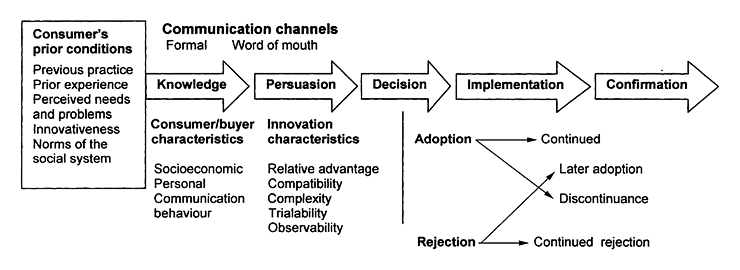FOOD
PRODUCT DEVELOPMENT
Mary Earle, Richard Earle and Allan Anderson |
| Loading
|
of new products |
|
||||
|
|
|
Part
2, Chapter 5
The consumer in product development 5.3 Consumers' avoidance and acceptance of new products Consumers tend to avoid new foods - a phenomenon called food neophobia. This is the reason for free samples or in-store tasting of new products; and also a great deal of information with new products. In a Swedish study (Koivisto-Hursti
and Sjoden, 1997), fathers avoided new foods more than mothers, and children more than their parents, generally younger children avoided new foods more than older children.
Neophobia is related to the marketing classification of consumers in relation to new products as adopters and non-adopters, or innovators, influentials, followers and diehards. Innovativeness is the degree that a consumer will try new products, that is how venturesome they are and how prepared they are to take risks. They recognise a perceived risk in the new product as well as the product attributes and benefits that relate to their needs and problems. Other consumer conditions affecting adoption of new products are previous practice and prior experience with new products. Prior experience has an effect on new food choice, leading to early acceptance or rejection of the new product. Some people may take the risk of not liking the food or even of safety, and try the new food; other people wait to hear reports on the product. Some consumers are actively looking for new foods and try many new products. In product development, it is important to identify the different types of consumers and to provide the knowledge in the total product concept to overcome their perceptions of risks. Consumers' prior conditions are an important basis for the diffusion of new products through the target market. If the company understands the different types of people and how they can be encouraged to try new products, then it can plan the product launch to give the optimum diffusion of the new product through the target market. The stages in the adoption process can be summarised as (1) awareness, (2) interest, (3) evaluation, (4) trial and (5) adoption or rejection (Schiffman and Kanuk, 2000). A more detailed innovation-decision process (Rogers, 1983) is summarised in Fig. 5.5.  Fig. 5.5 Rogers' model of the innovation-decision process. (Reprinted with permission of the Free Press, a Division of Simon and Schuster, Inc., from Diffusion of Innovations, Fourth Edition by Everett M. Rogers. Copyright © 1995 Everett M. Rogers. Copyright © 1962, 1971, 1983 by the Free Press.) (- click to enlarge) The total product concept can be designed to give controlled diffusion by understanding the diffusion variables (Engel et al., 1995; Schiffman and Kanuk, 2000):  Innovation type: continuous innovation, dynamically continuous Innovation type: continuous innovation, dynamically continuous innovation, discontinuous innovation; related to the increasing level of disruption of the consumers' behaviour patterns.  Characteristics of the total product concept to the consumer: Characteristics of the total product concept to the consumer: relative advantage, compatibility, complexity, trialability, observability. (a) Relative advantage is the perceived superiority to existing products. (b) Compatibility is the relation to present needs, values and practices. (c) Complexity is the difficulty in understanding and using the product. (d) Trialability is the degree to which the product can be tried on a limited basis. (e) Observability is the ease that the product and its benefits can be observed, imagined or described.  Communication: from marketer to consumer through media, public Communication: from marketer to consumer through media, public relations, opinion leaders, sales promotion, shows, Internet; and from consumer to consumer by word of mouth.  Time for adoption: the time for problem recognition, knowledge, Time for adoption: the time for problem recognition, knowledge, persuasion, implementation (buy and use), confirmation and re-buy.  Social system: ethnic, social, education, literacy, upward social Social system: ethnic, social, education, literacy, upward social mobility, commercial, size of units, technological level. |
|
 |